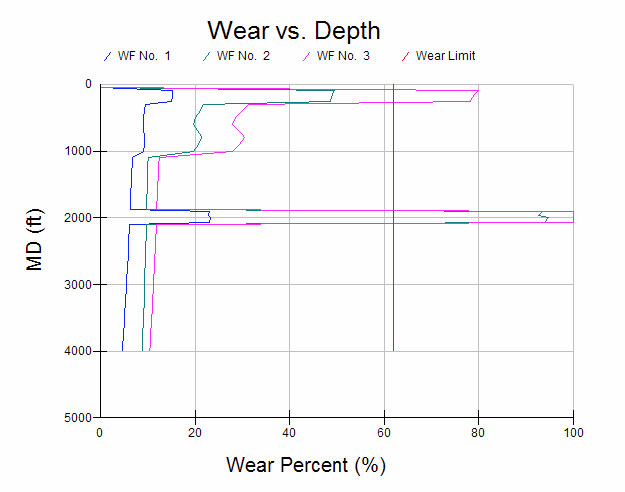With the results of the directional survey added to the drilling program covering the measured depth interval from intermediate casing seat to the next casing point, you have enough information to run CWPRO and to determine the significance of the results. Casing wear analysis run at this time will allow you to spotlight possible wear problems in time to take proactive remedial action.
I have employed a procedure which determines the location and estimates the seriousness of potential casing wear problems. A sample of the significant data from such a procedure is shown in Figure 1 and 2. The procedure is as follows.
Run CWPRO with 3 different wear factors, such as, in this example, 0.5, 5.0 and 10.0. This will cover the normal range to be expected from steel tool joints and steel casing running in an unweighted water based drilling fluid.
Looking at the three casing wear vs. measured depth plots, the highest casing wear values occur at about 2,000 ft. measured depth.
If there was no excessive casing wear associated with the wear factor = 10.0, you probably will have no problems.
However, in the example shown in Figure 1 and 2, casing wear associated with a wear factor of 10 is drastic.
Since WF 10.0 is at the upper end of expected wear factors associated with steel casing and tool joints running in unweighted water based mud, and since there is excessive (disastrous !) casing wear associated with the wear factor = 10.0, you must look at the casing wear predicted for the wear factor = 5.0, and hope that the results are more favorable.
If there is no excessive casing wear associated with the wear factor = 5.0, you probably have no problems, but proceed with caution.
What is ‘excessive casing wear’? This you should decide before you run the casing wear analysis.
The casing wear predicted for the wear factor = 5.0 is 94.7%. This is undoubtedly ‘excessive’.
Therefore, you look at the casing wear predicted for the wear factor = 0.5. This is about the smallest wear factor that you can expect from proprietary tool joints and steel casing run in an unweighted water based drilling fluid.
- Add lubricant to water based mud;
- Install proprietary hardbanding on tool joints;
- Consider using rubber pipe protectors; and/or
- Use downhole motors. (This reduces total drillstring rotations. This doesn’t reduce the wear rate, but it does reduce the total wear volume.)
If there is excessive casing wear associated with the small wear factor = 0.5, you need to consider drastic means to reduce the rate of casing wear. Means to be considered are # 3 and #4 from the list above. At this time, I know of no proprietary hardbanding (#2 on the list) that is associated with a wear factor less than 0.5.
In order to execute the above procedure, you must decide what ‘excessive casing wear’ is. Usually, this is based on consideration of acceptable burst and/or collapse values.
For this example, pictured in Fig.1, we arbitrarily define ‘excessive casing wear’ as being greater than 62 %.
Therefore, in the example shown in Fig.1, casing wear at measured depth of 2,000 ft. is ‘excessive’ for the wear factors greater than 0.5.
If you have a reasonable estimate for the wear factor that will apply to the casing wear system you are considering, you might predict casing wear for the following three values of wear factor: (1) half the expected value, (2) the expected value, and (3) twice the expected value of wear factor. This will predict the expected casing wear values bounded by an optimistic and a pessimistic estimate.
For your information, the dogleg severity at measured depth = 2,000 ft. in this example is 6 degrees per 100 ft.


